GSB005 - Zara's Operating Model: A Comprehensive Case Study
VerifiedAdded on 2023/06/15
|18
|4766
|245
Case Study
AI Summary
This case study delves into Zara's operating model, exploring its core competencies, operational management issues, and strategic success. It examines Zara's approach to retailing, design, production, sourcing, and distribution, comparing its strategies with those of other firms. The analysis covers Zara's quick inventory turnover, flexible production, and efficient supply chain, highlighting its ability to respond rapidly to customer demand. The report also addresses challenges related to Zara's distribution strategy and explores its online presence and future prospects. This document is available on Desklib, a platform offering study tools and resources for students.
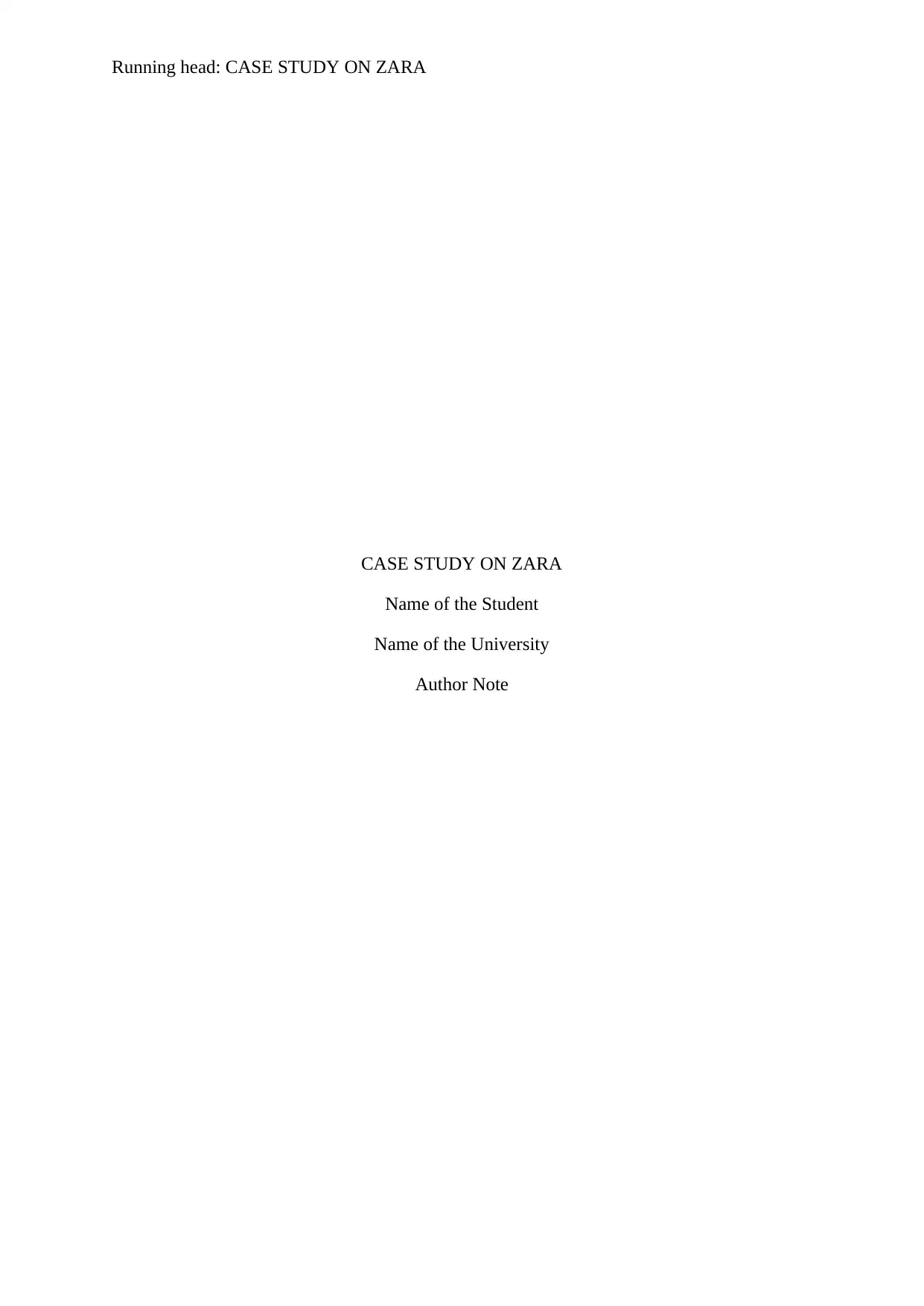
Running head: CASE STUDY ON ZARA
CASE STUDY ON ZARA
Name of the Student
Name of the University
Author Note
CASE STUDY ON ZARA
Name of the Student
Name of the University
Author Note
Paraphrase This Document
Need a fresh take? Get an instant paraphrase of this document with our AI Paraphraser
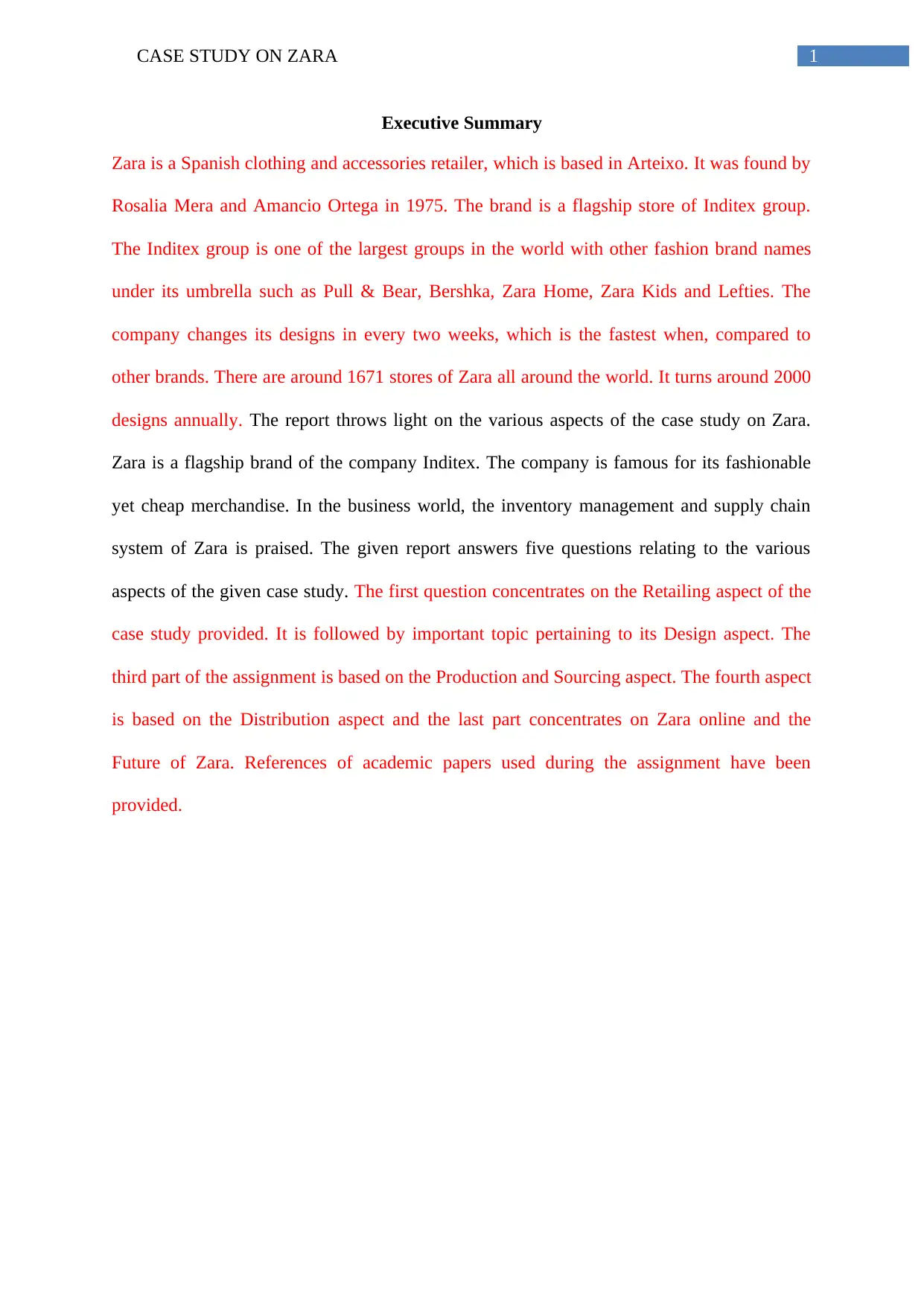
1CASE STUDY ON ZARA
Executive Summary
Zara is a Spanish clothing and accessories retailer, which is based in Arteixo. It was found by
Rosalia Mera and Amancio Ortega in 1975. The brand is a flagship store of Inditex group.
The Inditex group is one of the largest groups in the world with other fashion brand names
under its umbrella such as Pull & Bear, Bershka, Zara Home, Zara Kids and Lefties. The
company changes its designs in every two weeks, which is the fastest when, compared to
other brands. There are around 1671 stores of Zara all around the world. It turns around 2000
designs annually. The report throws light on the various aspects of the case study on Zara.
Zara is a flagship brand of the company Inditex. The company is famous for its fashionable
yet cheap merchandise. In the business world, the inventory management and supply chain
system of Zara is praised. The given report answers five questions relating to the various
aspects of the given case study. The first question concentrates on the Retailing aspect of the
case study provided. It is followed by important topic pertaining to its Design aspect. The
third part of the assignment is based on the Production and Sourcing aspect. The fourth aspect
is based on the Distribution aspect and the last part concentrates on Zara online and the
Future of Zara. References of academic papers used during the assignment have been
provided.
Executive Summary
Zara is a Spanish clothing and accessories retailer, which is based in Arteixo. It was found by
Rosalia Mera and Amancio Ortega in 1975. The brand is a flagship store of Inditex group.
The Inditex group is one of the largest groups in the world with other fashion brand names
under its umbrella such as Pull & Bear, Bershka, Zara Home, Zara Kids and Lefties. The
company changes its designs in every two weeks, which is the fastest when, compared to
other brands. There are around 1671 stores of Zara all around the world. It turns around 2000
designs annually. The report throws light on the various aspects of the case study on Zara.
Zara is a flagship brand of the company Inditex. The company is famous for its fashionable
yet cheap merchandise. In the business world, the inventory management and supply chain
system of Zara is praised. The given report answers five questions relating to the various
aspects of the given case study. The first question concentrates on the Retailing aspect of the
case study provided. It is followed by important topic pertaining to its Design aspect. The
third part of the assignment is based on the Production and Sourcing aspect. The fourth aspect
is based on the Distribution aspect and the last part concentrates on Zara online and the
Future of Zara. References of academic papers used during the assignment have been
provided.
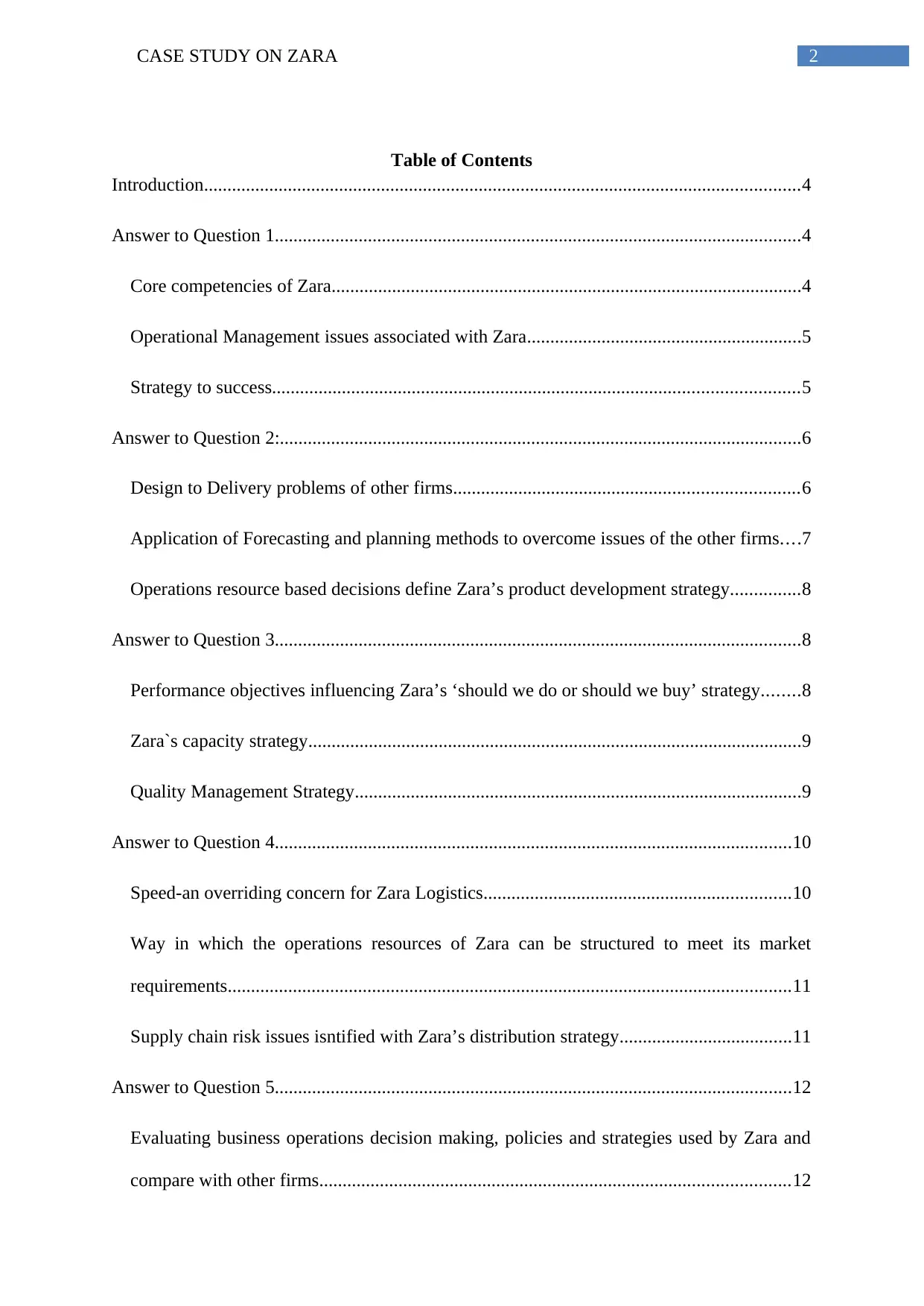
2CASE STUDY ON ZARA
Table of Contents
Introduction................................................................................................................................4
Answer to Question 1.................................................................................................................4
Core competencies of Zara.....................................................................................................4
Operational Management issues associated with Zara...........................................................5
Strategy to success.................................................................................................................5
Answer to Question 2:................................................................................................................6
Design to Delivery problems of other firms..........................................................................6
Application of Forecasting and planning methods to overcome issues of the other firms....7
Operations resource based decisions define Zara’s product development strategy...............8
Answer to Question 3.................................................................................................................8
Performance objectives influencing Zara’s ‘should we do or should we buy’ strategy........8
Zara`s capacity strategy..........................................................................................................9
Quality Management Strategy................................................................................................9
Answer to Question 4...............................................................................................................10
Speed-an overriding concern for Zara Logistics..................................................................10
Way in which the operations resources of Zara can be structured to meet its market
requirements.........................................................................................................................11
Supply chain risk issues isntified with Zara’s distribution strategy.....................................11
Answer to Question 5...............................................................................................................12
Evaluating business operations decision making, policies and strategies used by Zara and
compare with other firms.....................................................................................................12
Table of Contents
Introduction................................................................................................................................4
Answer to Question 1.................................................................................................................4
Core competencies of Zara.....................................................................................................4
Operational Management issues associated with Zara...........................................................5
Strategy to success.................................................................................................................5
Answer to Question 2:................................................................................................................6
Design to Delivery problems of other firms..........................................................................6
Application of Forecasting and planning methods to overcome issues of the other firms....7
Operations resource based decisions define Zara’s product development strategy...............8
Answer to Question 3.................................................................................................................8
Performance objectives influencing Zara’s ‘should we do or should we buy’ strategy........8
Zara`s capacity strategy..........................................................................................................9
Quality Management Strategy................................................................................................9
Answer to Question 4...............................................................................................................10
Speed-an overriding concern for Zara Logistics..................................................................10
Way in which the operations resources of Zara can be structured to meet its market
requirements.........................................................................................................................11
Supply chain risk issues isntified with Zara’s distribution strategy.....................................11
Answer to Question 5...............................................................................................................12
Evaluating business operations decision making, policies and strategies used by Zara and
compare with other firms.....................................................................................................12
⊘ This is a preview!⊘
Do you want full access?
Subscribe today to unlock all pages.

Trusted by 1+ million students worldwide

3CASE STUDY ON ZARA
Comparison with other brands.............................................................................................13
Factors influencing Zara`s process system..........................................................................14
Conclusion................................................................................................................................15
References................................................................................................................................16
Comparison with other brands.............................................................................................13
Factors influencing Zara`s process system..........................................................................14
Conclusion................................................................................................................................15
References................................................................................................................................16
Paraphrase This Document
Need a fresh take? Get an instant paraphrase of this document with our AI Paraphraser
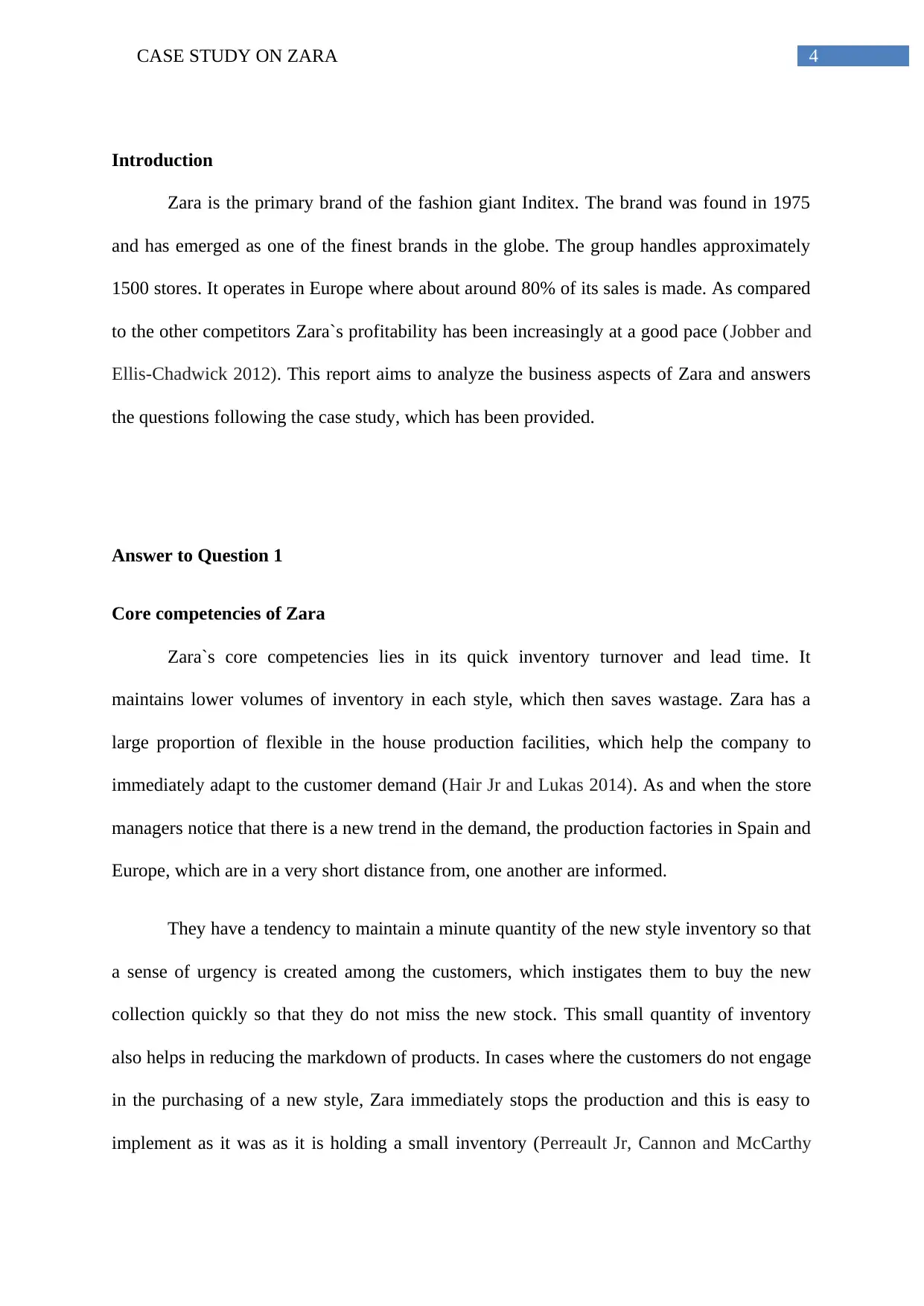
4CASE STUDY ON ZARA
Introduction
Zara is the primary brand of the fashion giant Inditex. The brand was found in 1975
and has emerged as one of the finest brands in the globe. The group handles approximately
1500 stores. It operates in Europe where about around 80% of its sales is made. As compared
to the other competitors Zara`s profitability has been increasingly at a good pace (Jobber and
Ellis-Chadwick 2012). This report aims to analyze the business aspects of Zara and answers
the questions following the case study, which has been provided.
Answer to Question 1
Core competencies of Zara
Zara`s core competencies lies in its quick inventory turnover and lead time. It
maintains lower volumes of inventory in each style, which then saves wastage. Zara has a
large proportion of flexible in the house production facilities, which help the company to
immediately adapt to the customer demand (Hair Jr and Lukas 2014). As and when the store
managers notice that there is a new trend in the demand, the production factories in Spain and
Europe, which are in a very short distance from, one another are informed.
They have a tendency to maintain a minute quantity of the new style inventory so that
a sense of urgency is created among the customers, which instigates them to buy the new
collection quickly so that they do not miss the new stock. This small quantity of inventory
also helps in reducing the markdown of products. In cases where the customers do not engage
in the purchasing of a new style, Zara immediately stops the production and this is easy to
implement as it was as it is holding a small inventory (Perreault Jr, Cannon and McCarthy
Introduction
Zara is the primary brand of the fashion giant Inditex. The brand was found in 1975
and has emerged as one of the finest brands in the globe. The group handles approximately
1500 stores. It operates in Europe where about around 80% of its sales is made. As compared
to the other competitors Zara`s profitability has been increasingly at a good pace (Jobber and
Ellis-Chadwick 2012). This report aims to analyze the business aspects of Zara and answers
the questions following the case study, which has been provided.
Answer to Question 1
Core competencies of Zara
Zara`s core competencies lies in its quick inventory turnover and lead time. It
maintains lower volumes of inventory in each style, which then saves wastage. Zara has a
large proportion of flexible in the house production facilities, which help the company to
immediately adapt to the customer demand (Hair Jr and Lukas 2014). As and when the store
managers notice that there is a new trend in the demand, the production factories in Spain and
Europe, which are in a very short distance from, one another are informed.
They have a tendency to maintain a minute quantity of the new style inventory so that
a sense of urgency is created among the customers, which instigates them to buy the new
collection quickly so that they do not miss the new stock. This small quantity of inventory
also helps in reducing the markdown of products. In cases where the customers do not engage
in the purchasing of a new style, Zara immediately stops the production and this is easy to
implement as it was as it is holding a small inventory (Perreault Jr, Cannon and McCarthy
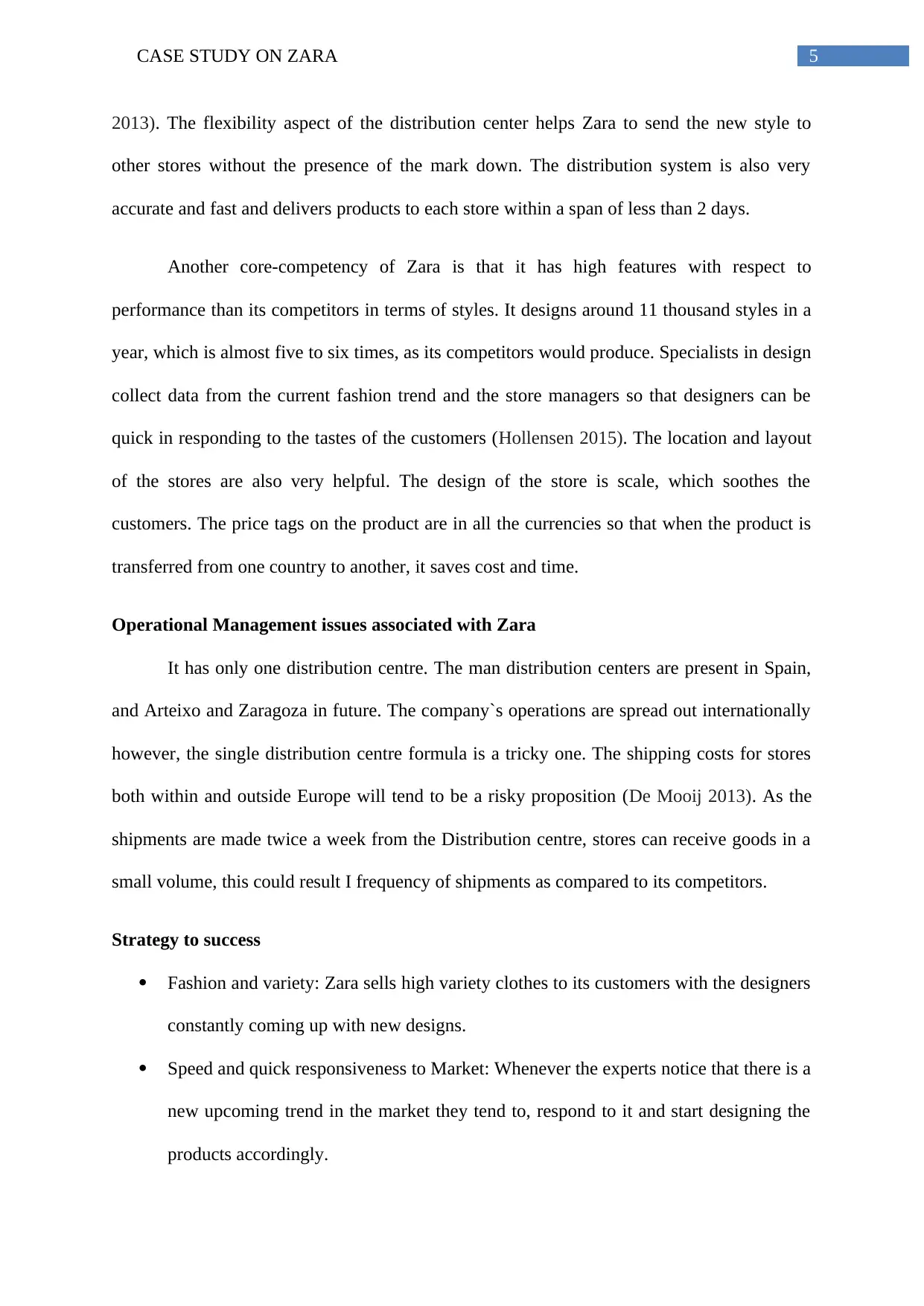
5CASE STUDY ON ZARA
2013). The flexibility aspect of the distribution center helps Zara to send the new style to
other stores without the presence of the mark down. The distribution system is also very
accurate and fast and delivers products to each store within a span of less than 2 days.
Another core-competency of Zara is that it has high features with respect to
performance than its competitors in terms of styles. It designs around 11 thousand styles in a
year, which is almost five to six times, as its competitors would produce. Specialists in design
collect data from the current fashion trend and the store managers so that designers can be
quick in responding to the tastes of the customers (Hollensen 2015). The location and layout
of the stores are also very helpful. The design of the store is scale, which soothes the
customers. The price tags on the product are in all the currencies so that when the product is
transferred from one country to another, it saves cost and time.
Operational Management issues associated with Zara
It has only one distribution centre. The man distribution centers are present in Spain,
and Arteixo and Zaragoza in future. The company`s operations are spread out internationally
however, the single distribution centre formula is a tricky one. The shipping costs for stores
both within and outside Europe will tend to be a risky proposition (De Mooij 2013). As the
shipments are made twice a week from the Distribution centre, stores can receive goods in a
small volume, this could result I frequency of shipments as compared to its competitors.
Strategy to success
Fashion and variety: Zara sells high variety clothes to its customers with the designers
constantly coming up with new designs.
Speed and quick responsiveness to Market: Whenever the experts notice that there is a
new upcoming trend in the market they tend to, respond to it and start designing the
products accordingly.
2013). The flexibility aspect of the distribution center helps Zara to send the new style to
other stores without the presence of the mark down. The distribution system is also very
accurate and fast and delivers products to each store within a span of less than 2 days.
Another core-competency of Zara is that it has high features with respect to
performance than its competitors in terms of styles. It designs around 11 thousand styles in a
year, which is almost five to six times, as its competitors would produce. Specialists in design
collect data from the current fashion trend and the store managers so that designers can be
quick in responding to the tastes of the customers (Hollensen 2015). The location and layout
of the stores are also very helpful. The design of the store is scale, which soothes the
customers. The price tags on the product are in all the currencies so that when the product is
transferred from one country to another, it saves cost and time.
Operational Management issues associated with Zara
It has only one distribution centre. The man distribution centers are present in Spain,
and Arteixo and Zaragoza in future. The company`s operations are spread out internationally
however, the single distribution centre formula is a tricky one. The shipping costs for stores
both within and outside Europe will tend to be a risky proposition (De Mooij 2013). As the
shipments are made twice a week from the Distribution centre, stores can receive goods in a
small volume, this could result I frequency of shipments as compared to its competitors.
Strategy to success
Fashion and variety: Zara sells high variety clothes to its customers with the designers
constantly coming up with new designs.
Speed and quick responsiveness to Market: Whenever the experts notice that there is a
new upcoming trend in the market they tend to, respond to it and start designing the
products accordingly.
⊘ This is a preview!⊘
Do you want full access?
Subscribe today to unlock all pages.

Trusted by 1+ million students worldwide
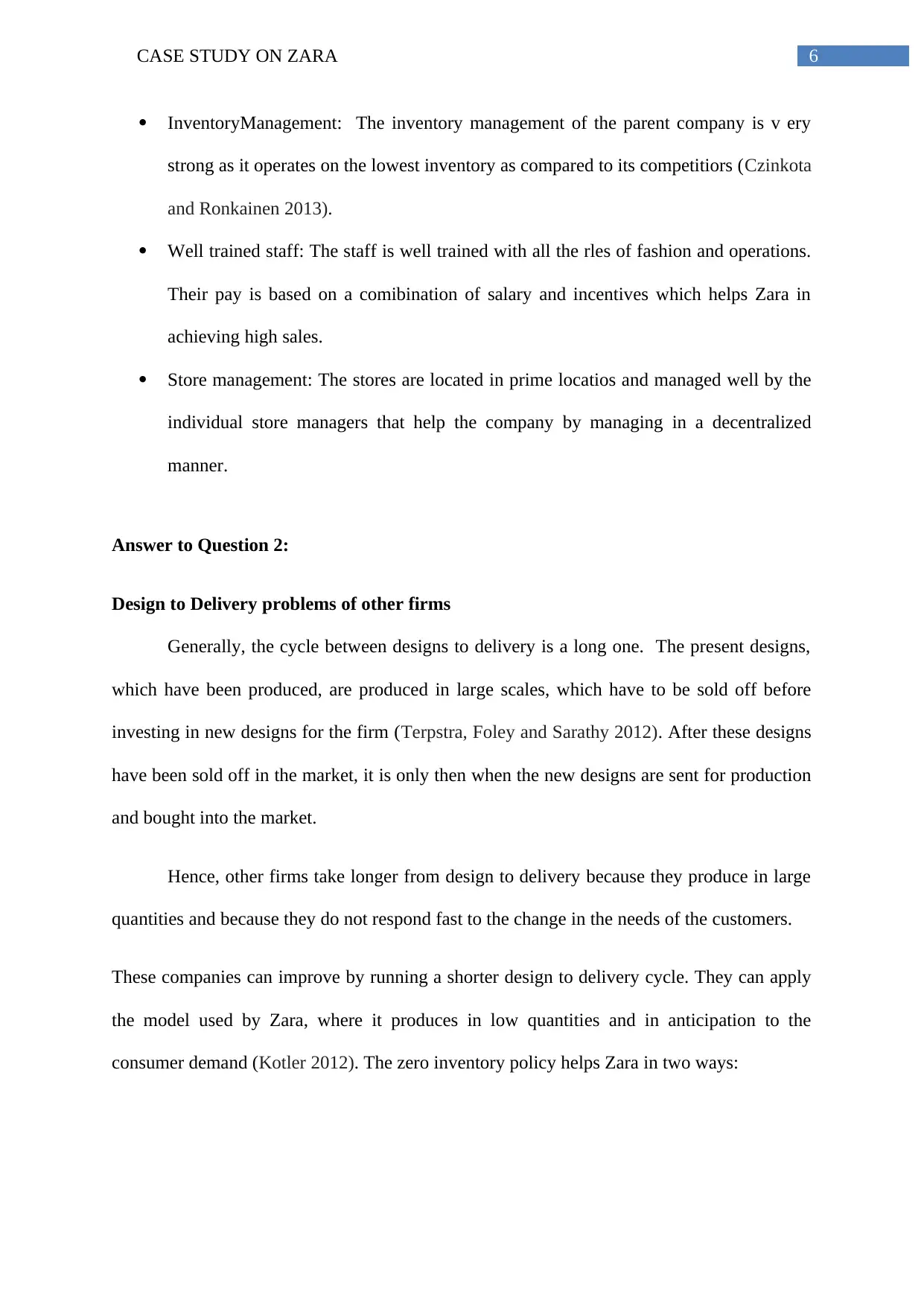
6CASE STUDY ON ZARA
InventoryManagement: The inventory management of the parent company is v ery
strong as it operates on the lowest inventory as compared to its competitiors (Czinkota
and Ronkainen 2013).
Well trained staff: The staff is well trained with all the rles of fashion and operations.
Their pay is based on a comibination of salary and incentives which helps Zara in
achieving high sales.
Store management: The stores are located in prime locatios and managed well by the
individual store managers that help the company by managing in a decentralized
manner.
Answer to Question 2:
Design to Delivery problems of other firms
Generally, the cycle between designs to delivery is a long one. The present designs,
which have been produced, are produced in large scales, which have to be sold off before
investing in new designs for the firm (Terpstra, Foley and Sarathy 2012). After these designs
have been sold off in the market, it is only then when the new designs are sent for production
and bought into the market.
Hence, other firms take longer from design to delivery because they produce in large
quantities and because they do not respond fast to the change in the needs of the customers.
These companies can improve by running a shorter design to delivery cycle. They can apply
the model used by Zara, where it produces in low quantities and in anticipation to the
consumer demand (Kotler 2012). The zero inventory policy helps Zara in two ways:
InventoryManagement: The inventory management of the parent company is v ery
strong as it operates on the lowest inventory as compared to its competitiors (Czinkota
and Ronkainen 2013).
Well trained staff: The staff is well trained with all the rles of fashion and operations.
Their pay is based on a comibination of salary and incentives which helps Zara in
achieving high sales.
Store management: The stores are located in prime locatios and managed well by the
individual store managers that help the company by managing in a decentralized
manner.
Answer to Question 2:
Design to Delivery problems of other firms
Generally, the cycle between designs to delivery is a long one. The present designs,
which have been produced, are produced in large scales, which have to be sold off before
investing in new designs for the firm (Terpstra, Foley and Sarathy 2012). After these designs
have been sold off in the market, it is only then when the new designs are sent for production
and bought into the market.
Hence, other firms take longer from design to delivery because they produce in large
quantities and because they do not respond fast to the change in the needs of the customers.
These companies can improve by running a shorter design to delivery cycle. They can apply
the model used by Zara, where it produces in low quantities and in anticipation to the
consumer demand (Kotler 2012). The zero inventory policy helps Zara in two ways:
Paraphrase This Document
Need a fresh take? Get an instant paraphrase of this document with our AI Paraphraser
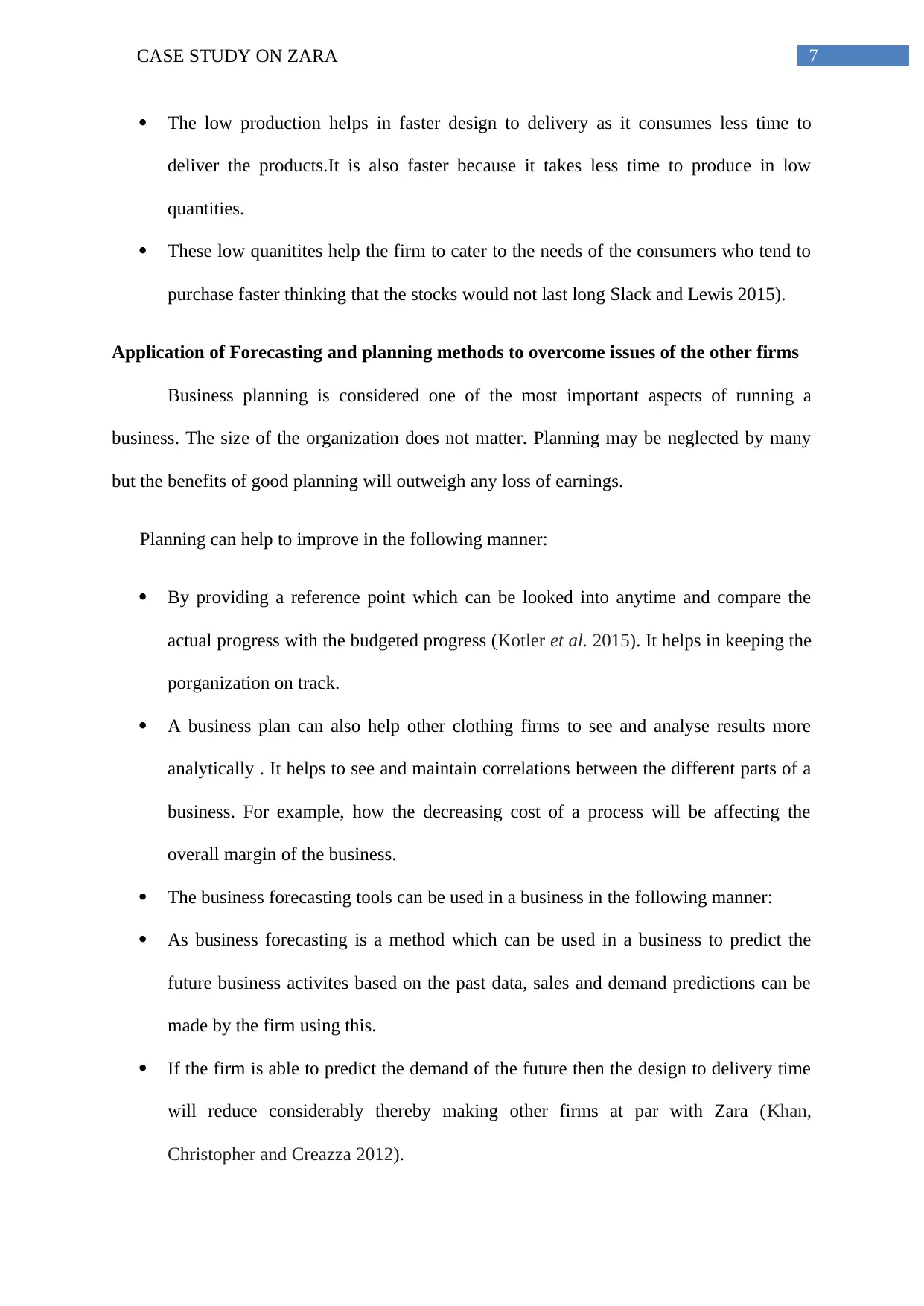
7CASE STUDY ON ZARA
The low production helps in faster design to delivery as it consumes less time to
deliver the products.It is also faster because it takes less time to produce in low
quantities.
These low quanitites help the firm to cater to the needs of the consumers who tend to
purchase faster thinking that the stocks would not last long Slack and Lewis 2015).
Application of Forecasting and planning methods to overcome issues of the other firms
Business planning is considered one of the most important aspects of running a
business. The size of the organization does not matter. Planning may be neglected by many
but the benefits of good planning will outweigh any loss of earnings.
Planning can help to improve in the following manner:
By providing a reference point which can be looked into anytime and compare the
actual progress with the budgeted progress (Kotler et al. 2015). It helps in keeping the
porganization on track.
A business plan can also help other clothing firms to see and analyse results more
analytically . It helps to see and maintain correlations between the different parts of a
business. For example, how the decreasing cost of a process will be affecting the
overall margin of the business.
The business forecasting tools can be used in a business in the following manner:
As business forecasting is a method which can be used in a business to predict the
future business activites based on the past data, sales and demand predictions can be
made by the firm using this.
If the firm is able to predict the demand of the future then the design to delivery time
will reduce considerably thereby making other firms at par with Zara (Khan,
Christopher and Creazza 2012).
The low production helps in faster design to delivery as it consumes less time to
deliver the products.It is also faster because it takes less time to produce in low
quantities.
These low quanitites help the firm to cater to the needs of the consumers who tend to
purchase faster thinking that the stocks would not last long Slack and Lewis 2015).
Application of Forecasting and planning methods to overcome issues of the other firms
Business planning is considered one of the most important aspects of running a
business. The size of the organization does not matter. Planning may be neglected by many
but the benefits of good planning will outweigh any loss of earnings.
Planning can help to improve in the following manner:
By providing a reference point which can be looked into anytime and compare the
actual progress with the budgeted progress (Kotler et al. 2015). It helps in keeping the
porganization on track.
A business plan can also help other clothing firms to see and analyse results more
analytically . It helps to see and maintain correlations between the different parts of a
business. For example, how the decreasing cost of a process will be affecting the
overall margin of the business.
The business forecasting tools can be used in a business in the following manner:
As business forecasting is a method which can be used in a business to predict the
future business activites based on the past data, sales and demand predictions can be
made by the firm using this.
If the firm is able to predict the demand of the future then the design to delivery time
will reduce considerably thereby making other firms at par with Zara (Khan,
Christopher and Creazza 2012).

8CASE STUDY ON ZARA
Business forecasting also helps in business planning which as stated earlier helps in
the functioning of the business. It also helps in effective managing of the firm.
Operations resource based decisions define Zara’s product development strategy
Zara has a unique system of design present. First, it takes designing inspirations from
the global trends in market, catwalks and magazines. The major source of its ideas is the
customer feedback. In its headquarters, the commercial team consists of market specialists as
well as buyers. This group together designs approximately 180,000 items in a year from
which about 10000 are chosen. Unlike other organizations these teams simultaneously work
on the next season`s design and also update the current designs. There are different rooms for
designing women`s, men`s and children’s wear (Ngai et al. 2015). The rooms are divided by
different products and they work in equal perimeters from one another. The environment of
the room is very encouraging and the layout is set in a way such that discussion is
encouraged.
The designs are first sketched by hand and then by using Computer Aided Designing.
One of the important aspects of the planning phase is that each design is discussed upon and t
is determined whether the design is capable of earning a profit or not.
All the sales managers as well as store managers are constantly in touch with the designers so
that real time decisions can be made. These decisions form a major part of the designing
process.
Answer to Question 3
Performance objectives influencing Zara’s ‘should we do or should we buy’ strategy
Required levels of speed and expertise- All the orders are different in nature and all of
them require a different level of expertise (Lueg, Pedersen and Clemmensen 2015).
Business forecasting also helps in business planning which as stated earlier helps in
the functioning of the business. It also helps in effective managing of the firm.
Operations resource based decisions define Zara’s product development strategy
Zara has a unique system of design present. First, it takes designing inspirations from
the global trends in market, catwalks and magazines. The major source of its ideas is the
customer feedback. In its headquarters, the commercial team consists of market specialists as
well as buyers. This group together designs approximately 180,000 items in a year from
which about 10000 are chosen. Unlike other organizations these teams simultaneously work
on the next season`s design and also update the current designs. There are different rooms for
designing women`s, men`s and children’s wear (Ngai et al. 2015). The rooms are divided by
different products and they work in equal perimeters from one another. The environment of
the room is very encouraging and the layout is set in a way such that discussion is
encouraged.
The designs are first sketched by hand and then by using Computer Aided Designing.
One of the important aspects of the planning phase is that each design is discussed upon and t
is determined whether the design is capable of earning a profit or not.
All the sales managers as well as store managers are constantly in touch with the designers so
that real time decisions can be made. These decisions form a major part of the designing
process.
Answer to Question 3
Performance objectives influencing Zara’s ‘should we do or should we buy’ strategy
Required levels of speed and expertise- All the orders are different in nature and all of
them require a different level of expertise (Lueg, Pedersen and Clemmensen 2015).
⊘ This is a preview!⊘
Do you want full access?
Subscribe today to unlock all pages.

Trusted by 1+ million students worldwide

9CASE STUDY ON ZARA
Therefore, the decision makers and planners were to decide whether in house
production was enough to meet the desired level of expertise that is required in a
certain requirement and whether they will be able to produce in time.
Cost effectiveness- The cost component is also extremely important. If buying means
it is cheaper then Zara considers it better to buy rather than producing in house.
Availability of sufficient capacity – If enough capacity is available in a particular
organization like Zara then the store decides on producing in house else otherwise it
opts for outsourcing.
Zara`s capacity strategy
A capacity strategy can be described as an approach to the fluctuating business
capacity to meet the demand. Zara operates on a zero inventory policy (Slack and Lewis
2015). It makes use of extensive forecasting techniques in other to anticipate and determine
the demand based on data of the past.
Hence, it can be stated that Zara makes use of dynamic capacity strategy. In a
dynamic strategy, the amount of capacity to be added is based on the requirement, which is
based on the forecasting of the firm (He 2012). This means that if Zara demands that 1500
different designs will be required in the next month then, it shall add the capacities
accordingly.
Quality Management Strategy
This strategy can be defined as the set of quality techniques and standards, which are
used and applied to achieve the required standard of products. The strategy lays down the
quality that is required to be achieved in all the projects undertaken by the firm. Zara has a
well-laid quality management strategy, which helps it to set particular standards for its
products.
Therefore, the decision makers and planners were to decide whether in house
production was enough to meet the desired level of expertise that is required in a
certain requirement and whether they will be able to produce in time.
Cost effectiveness- The cost component is also extremely important. If buying means
it is cheaper then Zara considers it better to buy rather than producing in house.
Availability of sufficient capacity – If enough capacity is available in a particular
organization like Zara then the store decides on producing in house else otherwise it
opts for outsourcing.
Zara`s capacity strategy
A capacity strategy can be described as an approach to the fluctuating business
capacity to meet the demand. Zara operates on a zero inventory policy (Slack and Lewis
2015). It makes use of extensive forecasting techniques in other to anticipate and determine
the demand based on data of the past.
Hence, it can be stated that Zara makes use of dynamic capacity strategy. In a
dynamic strategy, the amount of capacity to be added is based on the requirement, which is
based on the forecasting of the firm (He 2012). This means that if Zara demands that 1500
different designs will be required in the next month then, it shall add the capacities
accordingly.
Quality Management Strategy
This strategy can be defined as the set of quality techniques and standards, which are
used and applied to achieve the required standard of products. The strategy lays down the
quality that is required to be achieved in all the projects undertaken by the firm. Zara has a
well-laid quality management strategy, which helps it to set particular standards for its
products.
Paraphrase This Document
Need a fresh take? Get an instant paraphrase of this document with our AI Paraphraser
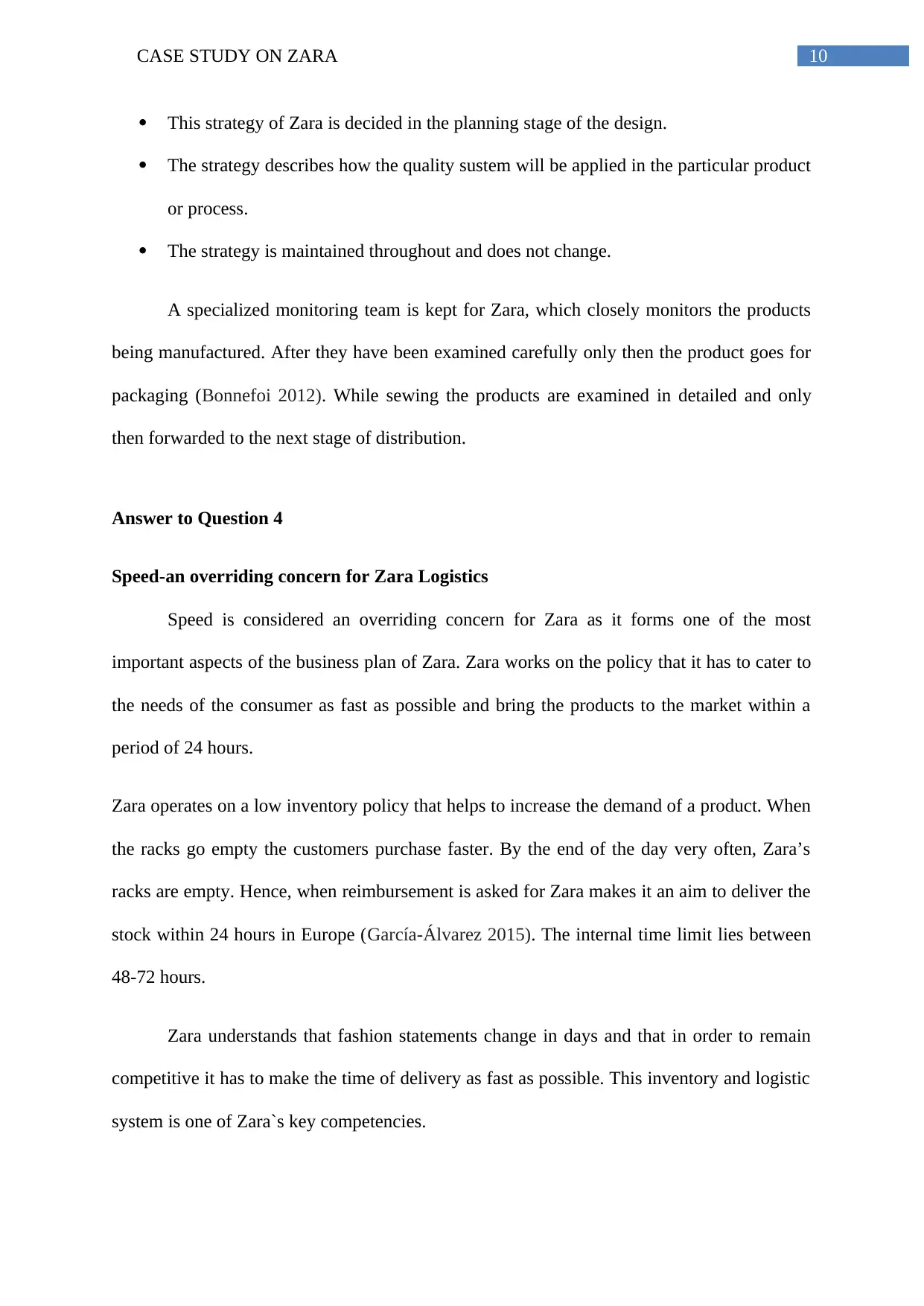
10CASE STUDY ON ZARA
This strategy of Zara is decided in the planning stage of the design.
The strategy describes how the quality sustem will be applied in the particular product
or process.
The strategy is maintained throughout and does not change.
A specialized monitoring team is kept for Zara, which closely monitors the products
being manufactured. After they have been examined carefully only then the product goes for
packaging (Bonnefoi 2012). While sewing the products are examined in detailed and only
then forwarded to the next stage of distribution.
Answer to Question 4
Speed-an overriding concern for Zara Logistics
Speed is considered an overriding concern for Zara as it forms one of the most
important aspects of the business plan of Zara. Zara works on the policy that it has to cater to
the needs of the consumer as fast as possible and bring the products to the market within a
period of 24 hours.
Zara operates on a low inventory policy that helps to increase the demand of a product. When
the racks go empty the customers purchase faster. By the end of the day very often, Zara’s
racks are empty. Hence, when reimbursement is asked for Zara makes it an aim to deliver the
stock within 24 hours in Europe (García-Álvarez 2015). The internal time limit lies between
48-72 hours.
Zara understands that fashion statements change in days and that in order to remain
competitive it has to make the time of delivery as fast as possible. This inventory and logistic
system is one of Zara`s key competencies.
This strategy of Zara is decided in the planning stage of the design.
The strategy describes how the quality sustem will be applied in the particular product
or process.
The strategy is maintained throughout and does not change.
A specialized monitoring team is kept for Zara, which closely monitors the products
being manufactured. After they have been examined carefully only then the product goes for
packaging (Bonnefoi 2012). While sewing the products are examined in detailed and only
then forwarded to the next stage of distribution.
Answer to Question 4
Speed-an overriding concern for Zara Logistics
Speed is considered an overriding concern for Zara as it forms one of the most
important aspects of the business plan of Zara. Zara works on the policy that it has to cater to
the needs of the consumer as fast as possible and bring the products to the market within a
period of 24 hours.
Zara operates on a low inventory policy that helps to increase the demand of a product. When
the racks go empty the customers purchase faster. By the end of the day very often, Zara’s
racks are empty. Hence, when reimbursement is asked for Zara makes it an aim to deliver the
stock within 24 hours in Europe (García-Álvarez 2015). The internal time limit lies between
48-72 hours.
Zara understands that fashion statements change in days and that in order to remain
competitive it has to make the time of delivery as fast as possible. This inventory and logistic
system is one of Zara`s key competencies.
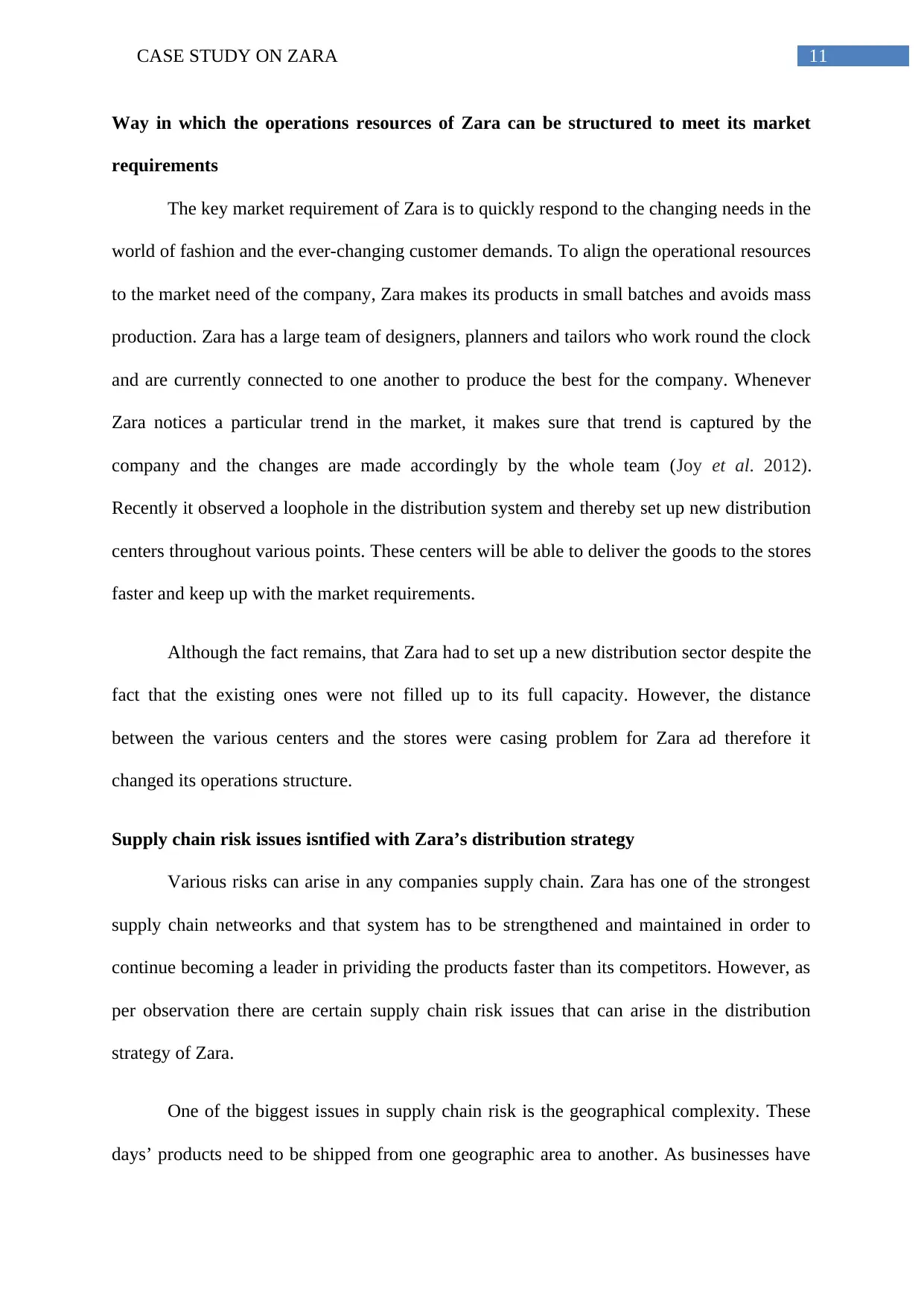
11CASE STUDY ON ZARA
Way in which the operations resources of Zara can be structured to meet its market
requirements
The key market requirement of Zara is to quickly respond to the changing needs in the
world of fashion and the ever-changing customer demands. To align the operational resources
to the market need of the company, Zara makes its products in small batches and avoids mass
production. Zara has a large team of designers, planners and tailors who work round the clock
and are currently connected to one another to produce the best for the company. Whenever
Zara notices a particular trend in the market, it makes sure that trend is captured by the
company and the changes are made accordingly by the whole team (Joy et al. 2012).
Recently it observed a loophole in the distribution system and thereby set up new distribution
centers throughout various points. These centers will be able to deliver the goods to the stores
faster and keep up with the market requirements.
Although the fact remains, that Zara had to set up a new distribution sector despite the
fact that the existing ones were not filled up to its full capacity. However, the distance
between the various centers and the stores were casing problem for Zara ad therefore it
changed its operations structure.
Supply chain risk issues isntified with Zara’s distribution strategy
Various risks can arise in any companies supply chain. Zara has one of the strongest
supply chain netweorks and that system has to be strengthened and maintained in order to
continue becoming a leader in prividing the products faster than its competitors. However, as
per observation there are certain supply chain risk issues that can arise in the distribution
strategy of Zara.
One of the biggest issues in supply chain risk is the geographical complexity. These
days’ products need to be shipped from one geographic area to another. As businesses have
Way in which the operations resources of Zara can be structured to meet its market
requirements
The key market requirement of Zara is to quickly respond to the changing needs in the
world of fashion and the ever-changing customer demands. To align the operational resources
to the market need of the company, Zara makes its products in small batches and avoids mass
production. Zara has a large team of designers, planners and tailors who work round the clock
and are currently connected to one another to produce the best for the company. Whenever
Zara notices a particular trend in the market, it makes sure that trend is captured by the
company and the changes are made accordingly by the whole team (Joy et al. 2012).
Recently it observed a loophole in the distribution system and thereby set up new distribution
centers throughout various points. These centers will be able to deliver the goods to the stores
faster and keep up with the market requirements.
Although the fact remains, that Zara had to set up a new distribution sector despite the
fact that the existing ones were not filled up to its full capacity. However, the distance
between the various centers and the stores were casing problem for Zara ad therefore it
changed its operations structure.
Supply chain risk issues isntified with Zara’s distribution strategy
Various risks can arise in any companies supply chain. Zara has one of the strongest
supply chain netweorks and that system has to be strengthened and maintained in order to
continue becoming a leader in prividing the products faster than its competitors. However, as
per observation there are certain supply chain risk issues that can arise in the distribution
strategy of Zara.
One of the biggest issues in supply chain risk is the geographical complexity. These
days’ products need to be shipped from one geographic area to another. As businesses have
⊘ This is a preview!⊘
Do you want full access?
Subscribe today to unlock all pages.

Trusted by 1+ million students worldwide
1 out of 18
Related Documents
Your All-in-One AI-Powered Toolkit for Academic Success.
+13062052269
info@desklib.com
Available 24*7 on WhatsApp / Email
![[object Object]](/_next/static/media/star-bottom.7253800d.svg)
Unlock your academic potential
Copyright © 2020–2025 A2Z Services. All Rights Reserved. Developed and managed by ZUCOL.





